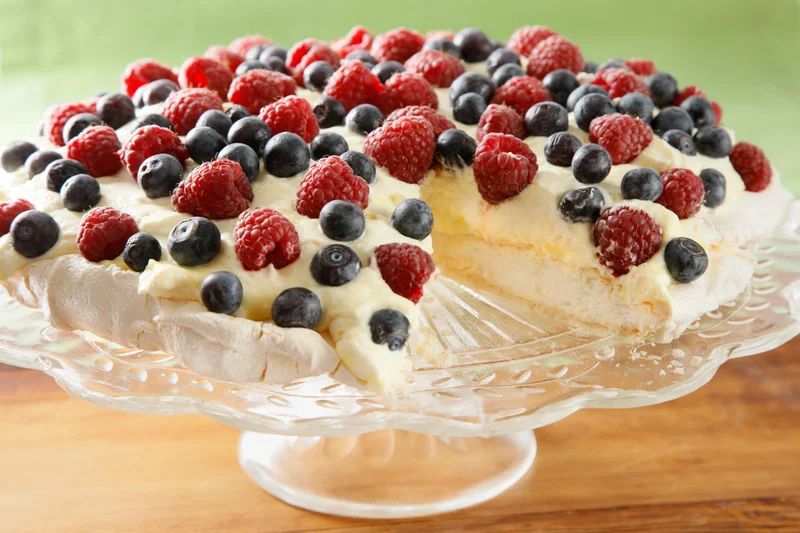Pavlova, named for the Russian ballerina Anna Pavlova after her 1920s tour through Australia, is an airy meringue cake topped with whipped cream. Popular in both Russia and Australia, the pavlova consists of a crisp shell base with a marshmallow-like interior. Our version is topped with tangy lemon-curd whipped cream and fresh berries—a light and elegant dessert.
Game plan: If you prefer to use prepared lemon curd, you’ll need 1 cup for this recipe.
This dish was featured as part of our Easter Desserts photo gallery.
- Yield: 8 to 10 servings
- Difficulty: Medium
- Total: About 45 mins, plus chilling, baking, and cooling time
Ingredients (16)
For the lemon curd:
- 4 large egg yolks (save the whites for the pavlova)
- 1/2 cup granulated sugar
- 1/4 cup finely grated, loosely packed lemon zest (from about 5 to 6 medium lemons)
- 1/3 cup freshly squeezed lemon juice (from about 3 to 4 lemons)
- 1/8 teaspoon fine salt
- 6 tablespoons unsalted butter (3/4 stick), cut into 6 pieces, at room temperature
For the pavlova:
- 4 large egg whites with no traces of yolk, at room temperature
- Pinch fine salt
- 1 cup granulated sugar
- 2 teaspoons cornstarch
- 1 teaspoon distilled white vinegar
- 1/2 teaspoon vanilla extract
To assemble:
- 1 cup cold heavy cream
- 1 tablespoon granulated sugar
- 1/2 teaspoon vanilla extract
- 1 1/2 cups fresh berries, such as raspberries, blackberries, blueberries, or sliced strawberries
Instructions
For the lemon curd:
- Fill a medium saucepan with 1 to 2 inches of water and bring it to a simmer over high heat; reduce the heat to low and keep the water at a bare simmer.
- Place all of the ingredients except the butter in a large heatproof bowl and whisk to combine. Set the bowl over, but not touching, the simmering water and whisk constantly until the yolks thicken and the mixture forms ribbons when the whisk is lifted from the bowl, about 7 to 10 minutes. (Check to make sure the water does not boil by periodically removing the bowl from the saucepan using a pot holder or dry towel. If the water boils, reduce the heat so the eggs do not curdle.)
- Remove the bowl from the simmering water; whisk in the butter one piece at a time, waiting until each piece is completely melted and incorporated before adding another.
- Set a fine-mesh strainer over a medium bowl. Strain the curd, pressing on the solids and scraping the extra curd clinging to the underside of the strainer into the bowl; discard the solids left in the strainer. Press a sheet of plastic wrap directly onto the surface of the curd to prevent a skin from forming. Refrigerate until set and chilled, at least 3 hours. (The curd can be made and refrigerated up to 2 days ahead.) While the curd sets, prepare the pavlova.
For the pavlova:
- Heat the oven to 250°F and arrange a rack in the middle. Using a 9-inch round cake pan, trace a circle onto a piece of parchment paper with a pen or marker. Flip the paper over and place it on a baking sheet (the traced circle should be visible); set aside.
- Place the egg whites and salt in the very clean, dry bowl of a stand mixer fitted with a clean, dry whisk attachment. Whisk on medium speed until the whites begin to lighten in color and only small bubbles remain, about 2 minutes. Increase the speed to high and very slowly add the sugar in a thin, continuous stream. Whisk until firm, shiny peaks form, resembling marshmallow crème (this is the meringue), about 3 minutes.
- Remove the bowl from the mixer and sift the cornstarch through a fine-mesh strainer into the meringue. Drizzle with the vinegar and vanilla and fold them into the meringue with a rubber spatula until no streaks of vanilla remain, being careful not to deflate the whites.
- Using the rubber spatula, pile the meringue into the center of the circle drawn on the parchment paper and smooth it to the edges of the circle to form a rough, even disk about 1 inch tall. (If the parchment shifts while spreading the meringue, weigh down two opposite corners with small, heavy objects like cans. Make sure to remove them before baking.) Bake until the meringue is firm to the touch but slightly soft in the middle, about 60 minutes. Remove from the oven, place the baking sheet on a wire rack, and let cool completely. Run a thin metal spatula under the meringue to loosen. Carefully slide it onto a serving platter or cake stand; set aside.
To assemble:
- Place the cream, sugar, and vanilla in the clean bowl of a stand mixer fitted with a whisk attachment. Beat on medium-high speed until soft peaks form, about 1 1/2 to 2 minutes.
- Remove the bowl and, using a rubber spatula, fold the chilled lemon curd into the whipped cream, leaving big streaks of curd and whipped cream. Pile the mixture into the center of the baked meringue and spread it to the edges.
- Top with the fresh berries and serve the pavlova immediately.

